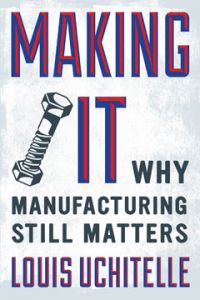
In this excerpt from his new book Making It: Why Manufacturing Still Matters, longtime economic reporter Louis Uchitelle explains just how our government is actually subsidizing manufacturing to the tune of billions of dollars — and makes the case for why we should be doing even more. Get additional perspective from Uchitelle on the rise and fall of the American factory worker, why we’re wrong about “skills” and how the death of inner-city manufacturing is a civil rights matter in our interview with the author.
In its heyday, no one talked of skills shortages in manufacturing, not as long as the demand for factory-made merchandise exceeded the supply. Somehow enough skilled workers were found to fill the jobs, or factories hired unskilled men and women and trained them. The issue arose as factories closed in the 1980s and thousands of people who wanted decent-paying factory jobs could no longer find them. The jobs ceased to exist while the workers who wanted them remained, and we were reluctant to acknowledge the shortfall.

Making It: Why Manufacturing Still Matters by Louis Uchitelle, The New Press, 2017.
Instead, we put the blame on the unemployed workers themselves, arguing in an epidemic of magical thinking that sophisticated, cutting-edge factories would emerge to replace offshored industries, but only if the unemployed acquired the skills to staff them. New factories did materialize, but not often enough in the United States. The skills needed to staff them, it turned out, existed (or could be acquired easily enough) in Asia and Latin America as well. American manufacturers, as a result, put more and more factories in those parts of the world and equipped them with sophisticated technologies. They did so not only to take advantage of labor pools with appropriate skills but because the demand for manufactured goods rose faster abroad — especially in Asia — than in the United States. In addition, governments on those continents offered subsidies — often generous ones. They recognized something that should have been axiomatic in every country, including the United States: manufacturing is not exclusively a market-dependent activity, and it rarely has been. The process of making physical products is too complicated, too capital intensive, and too dependent on costly and continuous innovation to pay for itself simply from a manufacturer’s own, sometimes uncertain, revenues. Governments must supply subsidies in one form or another to sustain this vital activity, and they do so.
We hesitate to call them subsidies, and that reluctance has worked against manufacturing in the United States. While most other industrial nations acknowledge their essential role, we hold back and in doing so allow what are in effect subsidies to be disbursed in haphazard ways. Rather than channel them to manufacturers who export their products, for example, or who bring production home from abroad — adding to the nation’s total factory output — we stand by as our cities and towns auction themselves off to manufacturers searching for factory sites, even if a new site is only a few cities away from the old factory and simply replaces production in the old plant rather than increasing it by much. That process spreads more than $80 billion a year across numerous manufacturers. Add to that the nearly $300 billion in annual Defense Department spending, which is really a subsidy dedicated to the manufacture of weapons and other war materiel, and the total is one-sixth of the value of what all of the nation’s factories produce each year. Yet public funding of manufacturing does not stop there. We must include the numerous ad hoc subsidies that big manufacturers manage to obtain from all levels of government, offering the often legitimate argument that without such funds, they could not make enough profit to justify staying in business or operating a factory in a particular locale.
In total, the flow of public money approaches 20 percent of the value generated in the manufacturing process.
The Revere Copper Company in Rome, New York, for example, has purchased from the New York state government, at cost, the huge quantity of electricity it needs to manufacture copper. This discount from the state power authority’s standard price has contributed significantly to Revere’s profitability. Similarly, in Louisville, Kentucky, the more than 700 employees at General Electric’s factory complex there paid a 2-percent wage tax imposed by the city government, which then rebated the money to GE. That’s a subsidy funded by GE’s own workers! And in Midland, Michigan, the Dow Chemical Company in 2013 opened a battery factory that cost $300 million to construct and equip. Because the batteries were designed to power electric car engines, the federal government paid much of the factory’s construction costs, with the justification that battery-powered vehicles were more likely to result in a greener environment than gasoline-powered ones. Manufacturing in the United States, in sum, is a publicly subsidized market activity. It thrives when the subsidies are generous and well targeted and when the citizenry understands their importance. That is the case in Germany, where manufacturing output has generated a steady 22 percent of the national income year after year 7 for at least 17 years, and the government is quite open about its participation. In the United States, by contrast, manufacturing’s share of GDP in that same period declined from 17 percent in 1998 to 12.1 percent in 2015, in part because our prevailing economic ideology blinds us to the way manufacturing really works in a modern economy, and we hold back on the public support that it requires. In no other industrial nation except Britain and Canada is so little of the economy devoted to manufacturing. The typical range of the sector’s share of GDP is between 15 percent (Russia) and 19 percent (Japan), with China and South Korea far above, at 32 percent and 31 percent, respectively. If manufacturing is the defining characteristic of an industrial nation, then the United States is gradually, imperceptibly retreating from that status for lack of a targeted, coordinated subsidy program.
We lament the lure of lower-wage labor overseas, but in fact the lure of subsidies offered by foreign governments frequently plays a more important role in a corporation’s decision to put a factory abroad rather than to expand production in the United States and export from home.
Copyright © 2017 by Louis Uchitelle. This excerpt originally appeared in Making It: Why Manufacturing Still Matters, published by The New Press, reprinted here with permission.




